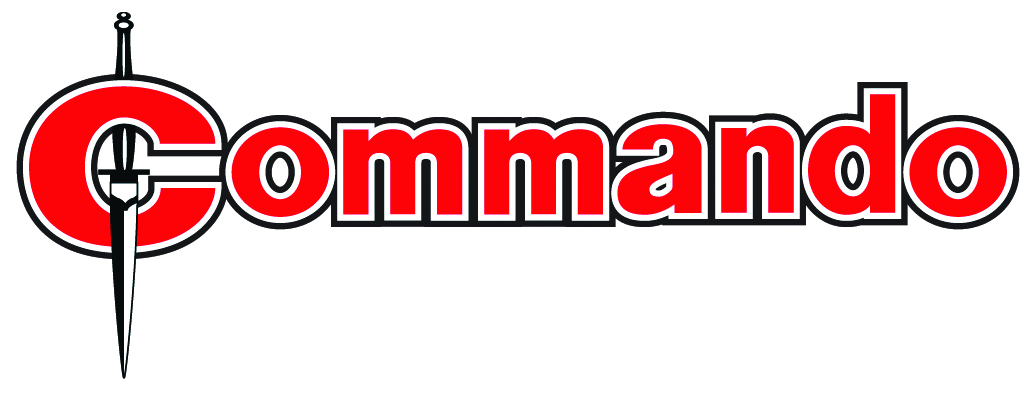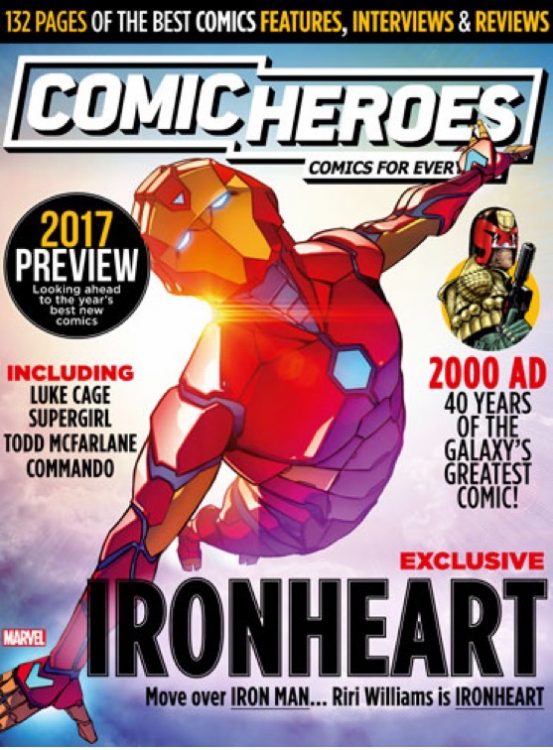As Dundee-based D C Thomson publishes the 5,000th issue of Commando, Paul F Cockburn asks how this iconic title continues to thrive.
 Commando For Action and Adventure—to give the line’s full title—is arguably British comics’ greatest survivor. Yes, 2000AD triumphantly published its 2,000th “prog” back in September 2016, but this small “digest” comic line—with its distinctive 18cm (7 inch) by 14cm (5.5 inch) format, black and white interior artwork and overt lack of ‘free gifts’—will soon see its 5,000th edition on the nation’s newsstands—in an uninterrupted run going back to July 1961!
Commando For Action and Adventure—to give the line’s full title—is arguably British comics’ greatest survivor. Yes, 2000AD triumphantly published its 2,000th “prog” back in September 2016, but this small “digest” comic line—with its distinctive 18cm (7 inch) by 14cm (5.5 inch) format, black and white interior artwork and overt lack of ‘free gifts’—will soon see its 5,000th edition on the nation’s newsstands—in an uninterrupted run going back to July 1961!
 “As a boy growing up in Belfast in the 1980s, Commando comics represented an escape to simpler times when bad guys screamed ‘Hände Hoch!’ and the brutal Boche could be put down by a simple punch to the jaw,” says 2000AD artist P J Holden. “It painted a world of bright explosive colours painted in the Technicolor™ glory of black and white. The fact that there were armed soldiers walking Belfast’s streets while I read war comics seemed to just make them cooler.”
“As a boy growing up in Belfast in the 1980s, Commando comics represented an escape to simpler times when bad guys screamed ‘Hände Hoch!’ and the brutal Boche could be put down by a simple punch to the jaw,” says 2000AD artist P J Holden. “It painted a world of bright explosive colours painted in the Technicolor™ glory of black and white. The fact that there were armed soldiers walking Belfast’s streets while I read war comics seemed to just make them cooler.”
First published by D C Thomson as Commando War Stories in Pictures—a blatant rival to Fleetway/IPC’s existing War Picture Library, launched in 1958—Commando’s distinctive logo has always featured a Fairbairn Sykes Commando knife plunged through the letter ‘C’. Britain’s real-world Commando forces are, of course, famed for their tenacity, but how has this single line of comics survived when so many others—weekly war comics such as Warlord and Battle, along with anthology titles like The Victor and Valiant—have fallen?
SURVIVAL
“Commando has a huge wealth of history to draw upon for inspiration, from the Cold War to the Roman Empire, which means there is plenty of opportunity for fresh and exciting stories to be told,” insists Kirsten Murray, current editor of ‘Heritage Brands’ at Dundee-based D C Thomson and the first woman to edit Commando during its 55 year history. “It often steps further than a battle between ‘good versus evil’, and instead questions a human’s actions in extraordinary, often punishing, circumstances. Since each issue brings a completely new story, readers are able to dip in and out of the collection as they please.”
Yet it can’t just be the subject matter; war stories were a staple of British children’s—and especially boys’—weekly titles for most of the 20th century, with the first really successful war comics—Warlord and Battle—not appearing until the early 1970s. Calum Laird, who was Commando’s fourth editor until he retired in 2015, is currently working on a PhD on the rise and fall of British War Comics and has spoken to many of the industry’s leading editors and contributors as part of his research.
“I spoke with Pat Mills, who’s famous for—amongst many things—‘Charlie’s War’, probably the ultimate British war comic story,” he says. “Pat felt that British comics lost their way in the 1980s, they became a bit self-indulgent and more concerned with a vocal minority than the generality of their readers—and, as a result, circulations began to fall. I first worked on Commando back in 1981 and the story values have never really changed; some of the language and characterisations have, but not the stories.
“Also, they were—are—meticulously researched; second editor Ian Forbes—who edited Commando for 17 years—wanted absolutely everything correct. He wouldn’t play fast and loose with tanks and guns; everything had to be right. His successor George Low inherited that structure, as did I. But going back to Pat Mills, he wanted to continue doing ‘Charlie’s War’ into the Second World War, and they wouldn’t give him a research budget to do it. And that was when he stopped writing it.
“The market for war comics, as it existed then, wanted things to be right,” insists Calum. “If you didn’t, you either had to go down the comedy route like ‘Captain Hurricane’ in the Valiant, or just give it up. That was definitely part of it; elsewhere standards began to slip, whereas Commando under Charles “Chick’ Checkley (editor: 1961-1971), Ian (1971-1988) and George (1988-2007) kept a tight grip on it. I have seen stories rejected on the basis that they were technically inaccurate.”
This attention to detail is something which illustrator Janek Matysiak, who drew his first Commando back in 1990 fresh out of art college, appreciates. “I do like the research, that it’s not just generic,” he says. “The language of Commando comes easy to me.” As with many of the people who have worked on the title in recent years, Janek grew up reading Commando. “My father was a D C Thomson artist—though he drew for Diana, Jackie and other girls comics—so during my childhood, I was given Victor, Hotspur, and Commando.”
DIGESTS
Commando has also outlived other titles which opted for a similar format; War Picture Library folded in 1984, as did later rival line Battle Picture Library (also Fleetway/IPC). Science fiction sister-title Starblazer—which now famously gave Grant Morrison some of his earliest work—lasted less than 12 years, vanishing in January 1991. “Starblazer was somewhat overtaken,” admits Calum. “It was going up against the likes of 2000AD, which were full colour and anthology as well. It had a hard furrow to hoe.”
Yet as other war comics and strips vanished from newsagent shelves, Commando flourished. “I believe that Commando’s highest ever monthly circulation was actually in 1984,” he adds, “by which time anyone who’s interested in British comics would tell you that nearly everything had disappeared. But if you wanted to read war stories, Commando became the only regular one.”
Arguably, another factor in Commando’s survival is the number of titles—currently, D C Thomson publishes four titles every fortnight, ensuring a “critical mass on a newsagent’s shelf”. Admittedly, at least half of these ‘new’ Commando comics are reprints from the company’s extensive back catalogue: including a “Gold Collection (of issues first published 50 years previously) and a Silver Collection (from 25 years ago). This is significant, however; the longterm consistency of Commando stories is simply confirmed by how little these have needed to be updated. “We had to change a little bit of the text sometimes,” Callum admits, “but not very often.”
This exploitable heritage—which has also seen stories reprinted in hardback editions by Carlton Books—is definitely a factor in Commando’s survival; so too has being published by D C Thomson. “Back in the 1980s, Thomson were probably the biggest single publisher of children’s and teen titles; they had a really sophisticated distribution system, so they could get Commando into the smallest newsagent,” Calum points out. “Thomson titles were also generally cheaper than the opposition— Dundee was a cheaper place to produce stuff than London, for a kick-off. As a firm, they didn’t have huge borrowings, they were very financially stable—and there were no public shareholders; that allowed them to plough their own furrow.”
21st CENTURY COMMANDO
Not that Commando is in any way stuck in the past. “War comics do face the difficult challenge of telling entertaining action stories whilst treating past events and the soldiers that served in action respectfully,” says current editor Kirsten Murray. “The face of the world has vastly changed since the eras in which many Commando stories are set, so it’s important to attempt to move away from stereotyping and language that would now be seen as offensive. We also steer clear of more recent conflicts, such as the war in the Middle East, as we are aware the impact of recent wars and military missions are still raw wounds for many.”
Calum agrees. “During George’s tenure, the scope of the conflicts widened out from the Second World War and there was a conscious decision to feature more heroes from the ‘other side’, because it became obvious that not all Germans were Nazis. It’s quite interesting to note that the Italians were the first to be rehabilitated in that respect, then the Germans—though, to a certain extent, the Japanese have never been rehabilitated in British war comics. Particularly during the Cold War there was definitely a reluctance to make the Russians the heroes, for fairly obvious reasons—although a lot of those ‘Enemy Hero’ stories took place in Russia!”
There’s also a practical reason for this. “You really need a good big canvas to tell a good story,” Calum adds. “The narrative of the Falklands War is very well known, for example, so it’s very difficult to weave fiction into it. It has been done successfully by a small number of our authors and artists, but you have to be really sure of what you’re doing.
So what of the future? Issue 5000 is written by prolific Commando contributor Ferg Handley, who also regularly writes Spectacular Spider-Man for Panini/Marvel UK. “We have a new editorial team in place which is passionate about the brand and the direction it can go in,” says Kirsten. “Despite Commando being 55 years old, we feel its potential is still largely untapped, so keep your eyes peeled for lots of exiting Commando this year.”
First published in Comic Heroes, #30 (January 2017).